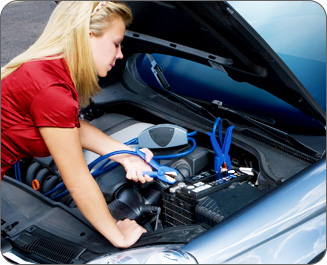Jumper Cables for Dummies!
 April 5, 2010
April 5, 2010  Post a Comment
Post a Comment
 What seems like an easy task to some, hooking up jumper cables, can actually be dangerous if not done correctly. Improper use of ordinary jumper cables can result in sparking or shorting, which can result in injury to the user. It can also produce a power surge that causes damage to a vehicle’s electrical system. And that’s bad news for your entertainment and navigation functions. Yes, it should be easy. The red battery cable goes to the positive side of the battery, and the black battery cable goes to go to the negative side of the battery. These days the usual recommendation is to connect the black battery cable to exposed metal on the engine block or the car frame to complete the ground. But if it’s dark, if the battery itself is poorly marked or just dirty, it may be difficult to make the connections properly. That’s where MICHELIN’S new Smart Jumper Cables come into play. They can help avoid problems during an improper jump-start. The first thing you notice is that these jumper cable ends are not marked with red or black, or negative or positive. That’s because it doesn’t matter how you hook them up. The built-in safety technology (a sealed box at the center of the cables) in Smart Jumper Cables provides surge protection and automatic polarity adjustment from either positive or negative connections. A green LED light tells you the circuits are complete. If the green LED light does not come on it might mean one of the cables is not making good contact. You’ll know which side isn’t making contact because there’s an LED light for both ends of the cables. They also have a textured grip to improve handling, especially in cold weather. But wait, there’s more! These cables stay flexible and tangle free because Michelin says they’re made with cold weather resistant materials. They also come with a sturdy zip-up storage case Under $40.
What seems like an easy task to some, hooking up jumper cables, can actually be dangerous if not done correctly. Improper use of ordinary jumper cables can result in sparking or shorting, which can result in injury to the user. It can also produce a power surge that causes damage to a vehicle’s electrical system. And that’s bad news for your entertainment and navigation functions. Yes, it should be easy. The red battery cable goes to the positive side of the battery, and the black battery cable goes to go to the negative side of the battery. These days the usual recommendation is to connect the black battery cable to exposed metal on the engine block or the car frame to complete the ground. But if it’s dark, if the battery itself is poorly marked or just dirty, it may be difficult to make the connections properly. That’s where MICHELIN’S new Smart Jumper Cables come into play. They can help avoid problems during an improper jump-start. The first thing you notice is that these jumper cable ends are not marked with red or black, or negative or positive. That’s because it doesn’t matter how you hook them up. The built-in safety technology (a sealed box at the center of the cables) in Smart Jumper Cables provides surge protection and automatic polarity adjustment from either positive or negative connections. A green LED light tells you the circuits are complete. If the green LED light does not come on it might mean one of the cables is not making good contact. You’ll know which side isn’t making contact because there’s an LED light for both ends of the cables. They also have a textured grip to improve handling, especially in cold weather. But wait, there’s more! These cables stay flexible and tangle free because Michelin says they’re made with cold weather resistant materials. They also come with a sturdy zip-up storage case Under $40.
I did a Daily Giz Wiz Netcast on this gizmo: www.twit.tv/dgw1046












Reader Comments